Ireland, Scotland and Crete 2017
In the early evening, we are whisked away from the airport in Heraklion. The taxi driver knows his way around and zooms in and out of the traffic with ease.
We are following an esplanade road with buildings to our left and sea wall and ships on the right. Our driver turns off and drives up a steep hill to our beautiful hotel with views of the port and ships coming and going. We are delighted to have such a good sea view from our hotel window - just what we booked from Australia.
We sleep in on our first morning and are happy that breakfast is served till 11am. We arrive at 9 and are ushered to a table. The Lato
Lesley Mackie
22 chapters
16 Apr 2020
Crete & Knossos
September 17, 2017
|
Heraklion
In the early evening, we are whisked away from the airport in Heraklion. The taxi driver knows his way around and zooms in and out of the traffic with ease.
We are following an esplanade road with buildings to our left and sea wall and ships on the right. Our driver turns off and drives up a steep hill to our beautiful hotel with views of the port and ships coming and going. We are delighted to have such a good sea view from our hotel window - just what we booked from Australia.
We sleep in on our first morning and are happy that breakfast is served till 11am. We arrive at 9 and are ushered to a table. The Lato
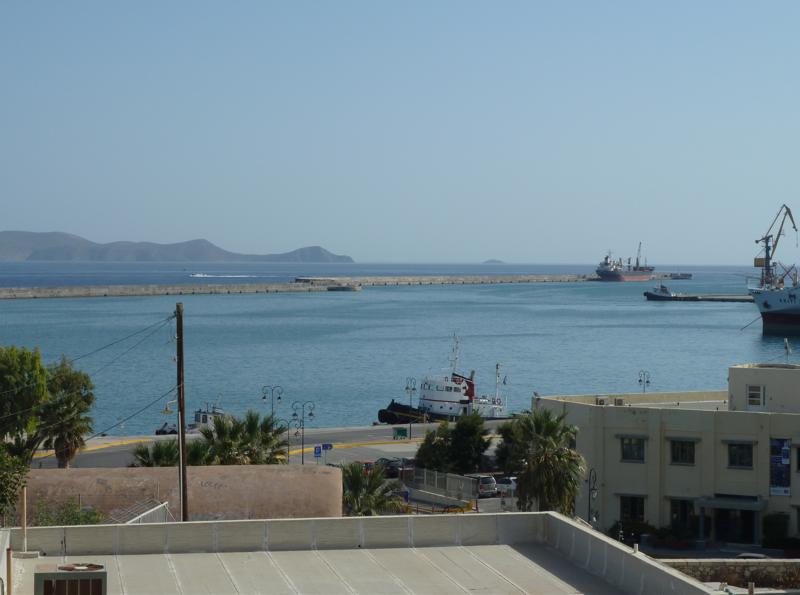
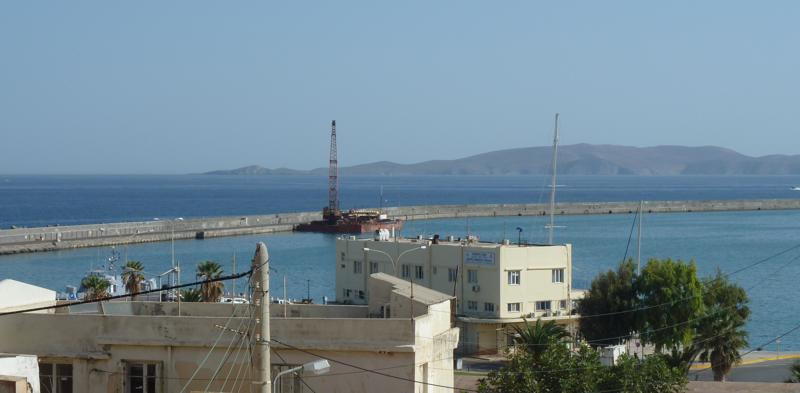
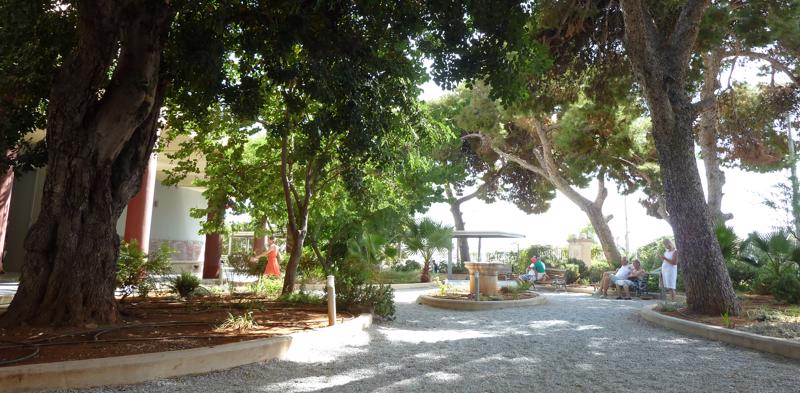
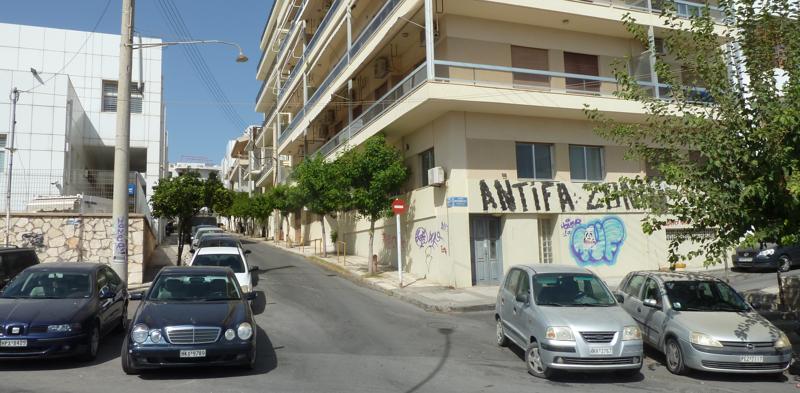
Boutique Hotel breakfast is scrumptious, so delicious in every way, and such a variety of foods. Firstly, there's the freshly squeezed orange juice, direct from the machine (the first of many we encountered here in the land of oranges) which you can operate yourself. By that I mean you can languidly pick up another orange or two from the basket and drop it down the chute to be squeezed out into your glass. Then as well as the usual English breakfast, bacon and eggs, and Continental breakfast, cakes, croissants and sweet sticky buns, they have a huge variety of cheeses and sliced cold meats.
The greek yoghurt is a stand-out - a huge vat with creamy white texture that tastes delicious. No wonder it's made its mark in the world. My favourite find in all the large white jars is the sweet orange preserve, a thin honeyed preserve that tastes amazing on my gf toast. Of course it runs over the edges and my fingers are dripping with the sticky stuff. Then I find the sweet grape preserve, crushed honeyed grapes. On the last morning I find a sweet fig preserve which I have not noticed before. Yummy but I know from past experience not to overeat figs which I love. There is also an assortment of nuts and seeds and dried fruits.
On our first evening in Heraklion we search for a typical Greek restaurant and find a 'hole in the wall' one with about a dozen tables. We are especially taken with the dolmios - wrapped rice. We eat a seafood dish and a mushroom risotto and drink red wine. Our waiter is very attentive. While he is waiting for the chef to prepare the dishes, he stands out front to encourage other diners in. A lovely first evening for us! Our days here at Heraklion are relaxing. We meander around the cobbled stone streets with other tourists and locals, stop here and there for coffee or a bite to eat, and window shop mostly at the myriad shops and market stalls. The roads are higgledy-piggledy on the hillside and we are amused to see people park their cars anywhere, even at street junctions. Motor bikes are whizzing around
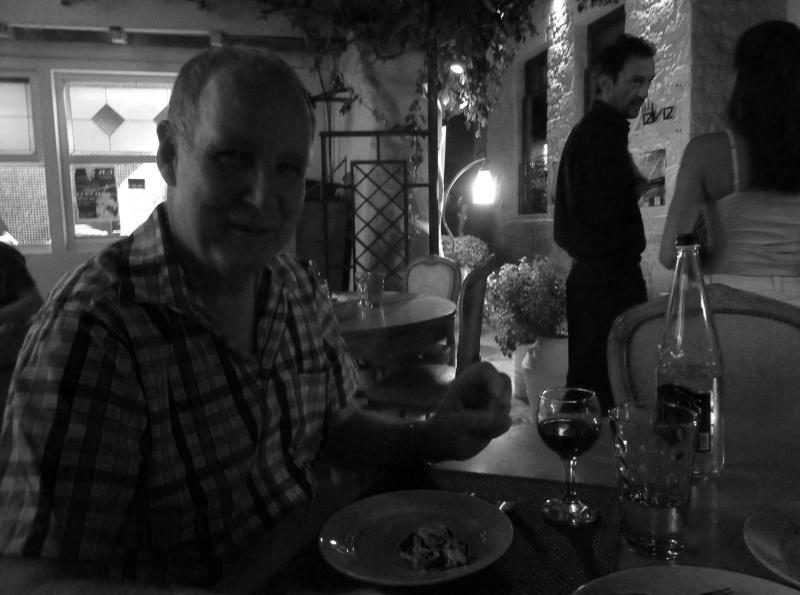
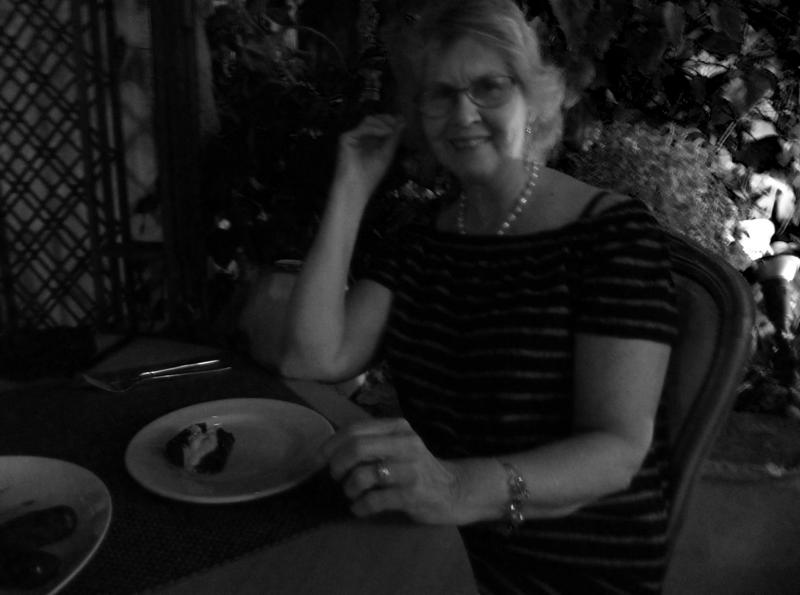
fast and we make sure to keep out of the way.
Back at the Lato, what amazes us, apart from the stunning water view, is how often the planes are taking off from Heraklion Airport not far away. They travel out to sea but past our hotel and they number one every ten minutes. Where are they going? All different airlines. We hear later that Crete is a favourite vacation spot for many Europeans - Russians, Spanish, Germans and then British, to name them in order of tourist populations in Crete.
Not far outside Heraklion in a southern direction is the archaeological site of Knossos and Tony had been very keen to visit this site. So we set out one morning, catching the bus to Knossos which is only about a half hour journey.
Knossos is the largest Bronze Age archaeological site in Crete and has been called Europe's oldest city. The first settlement in the area was in 7000BC and the first palace dates to around 1900BC. The people who lived there were of an unknown ethnicity, and later peoples called them Minoans. The palace became the ceremonial and political centre of Minoan civilization and culture. At its peak it is believed that a population of around 100,000 people lived in the city that surrounded the palace. This was around 1700BC.
When we arrive at the site, we pay our entrance fee and look around for a guide. Fortunately, there are guides of all nationalities waiting for tourists, and we soon find ourselves swept into a small group with an English-speaking guide. The weather is exceedingly hot
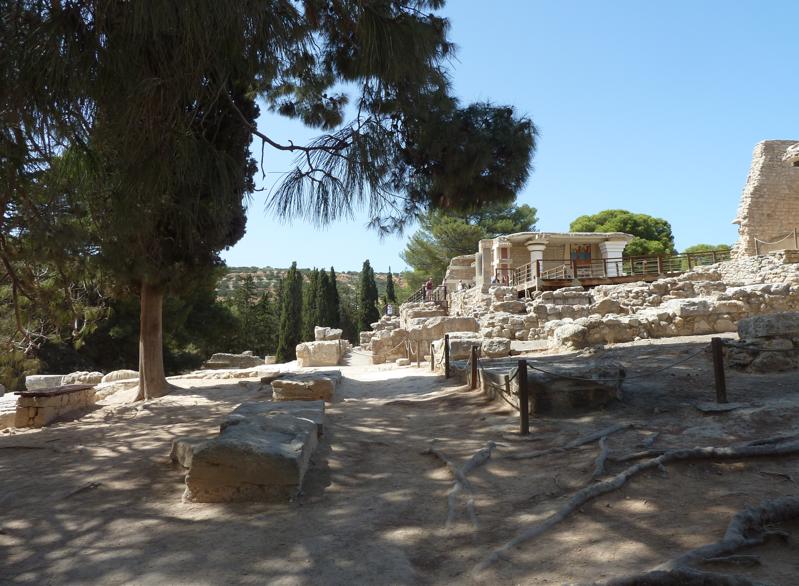
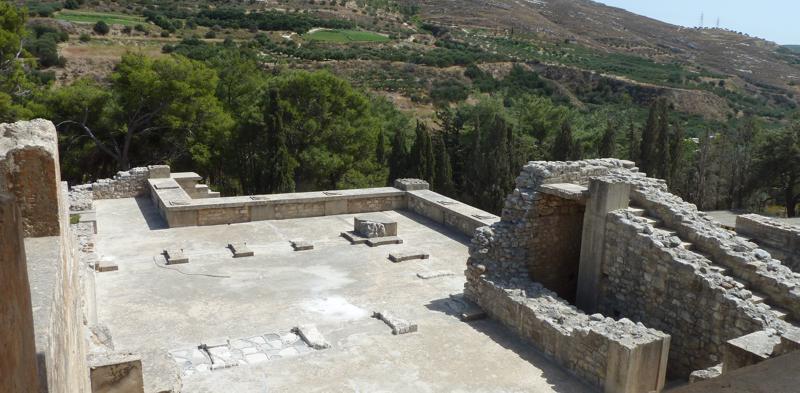
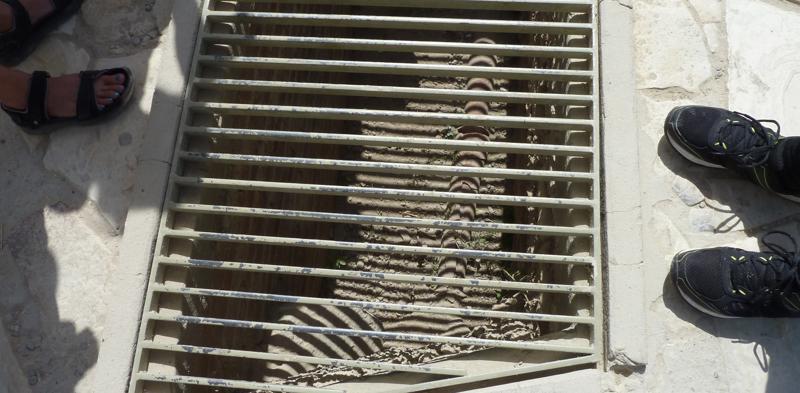
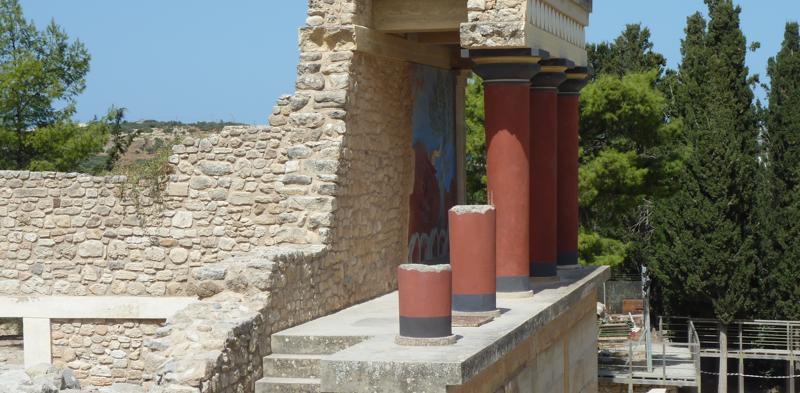
and we are glad we have hats on and sunscreen to wear. Some Europeans near us are bare-shouldered and with very pale skin, plus no head covering, and we wonder how they will survive the day.
The area covers around two football fields and there are hillsides to the south covered in rows of olive trees. We hear that there is a stream in a valley below the palace and the Minoans carried water from there. They also devised a system of clay pipes to carry rainwater, and what amazed us, was that they had learned to adjust the water pressure by varying the diameter of the pipes. Also, the Queen had a flushing toilet devised for her personal use. To think that this occurred back in 1700BC was more than amazing for us. I take a photo of clay pipes (possibly reconstructed and only seen under an iron grate) for water reticulation in the palace at that time. Of course there was no way devised at this time to pump water to the palace from the stream down the hillside. They would have carried water from the stream but relied on rainwater for their piped water on the hill.
I take photos of the descriptions and hypotheses written about the palace and have included some of these in my diary.
"A large part of the East Wing cannot be seen from the Central Court as it is built into the side of the hill on top of which lies the rest of the palace. Two storeys are preserved below the level of the Central Court. Today a large part of it has been reconstructed in concrete.
The storeys are connected with one another by means of a system of stairs known as the "Grand Staircase". The staircase was found during the excavation in its original position. There is a total of four flights of stairs, two for each storey. The steps are broad and deep, with a gentle incline that makes for an easy ascent. The staircase is lit by a large lightwell and was surrounded by a collonade of wooden columns".
"A series of corridors, spacious halls and small rooms is connected to the Grand Staircase. It is believed that the palace was the seat of the
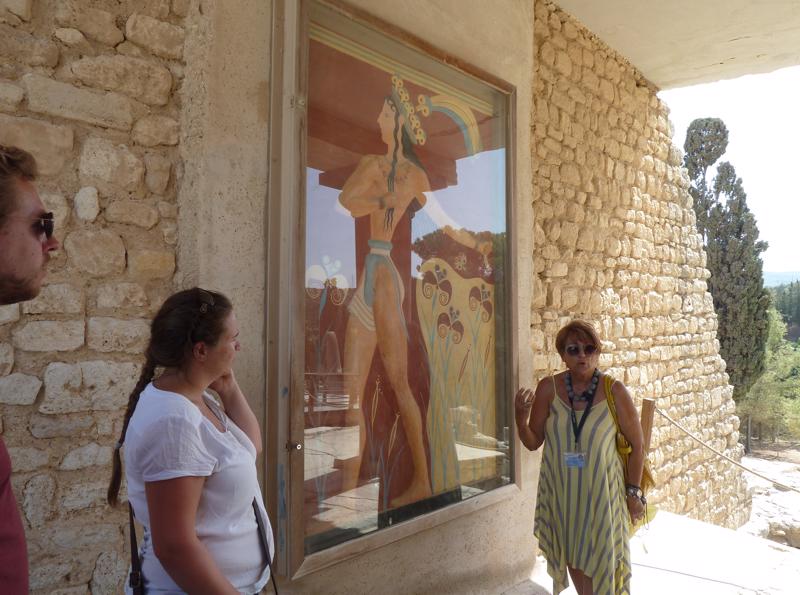
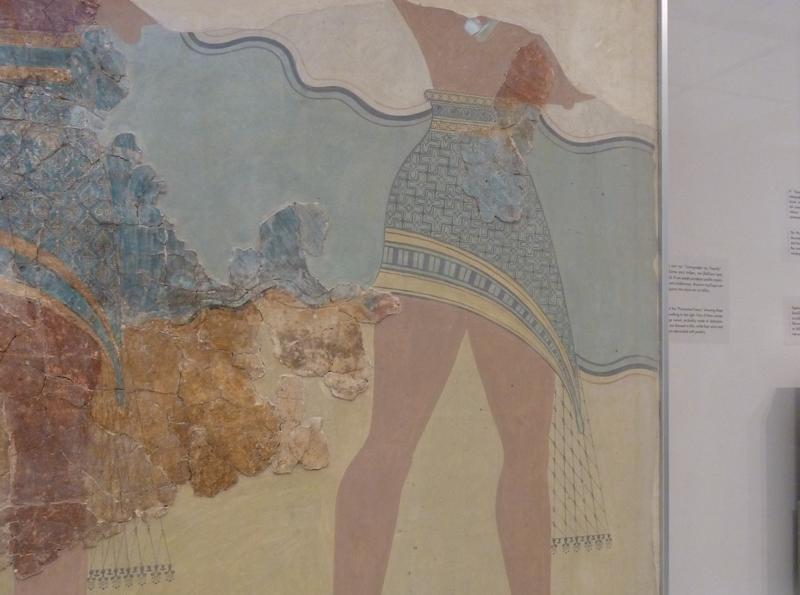
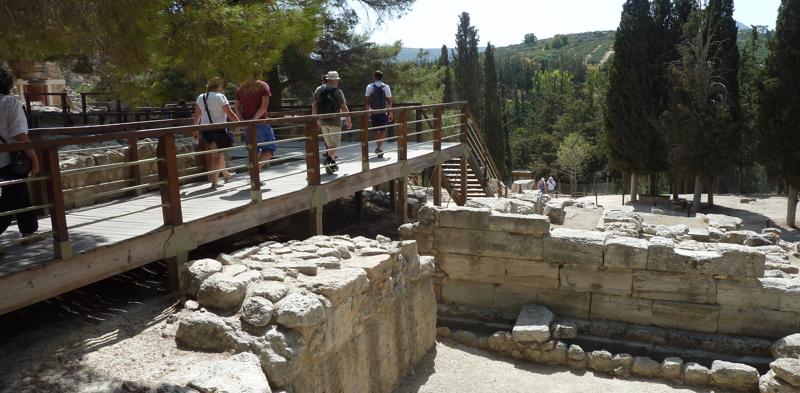
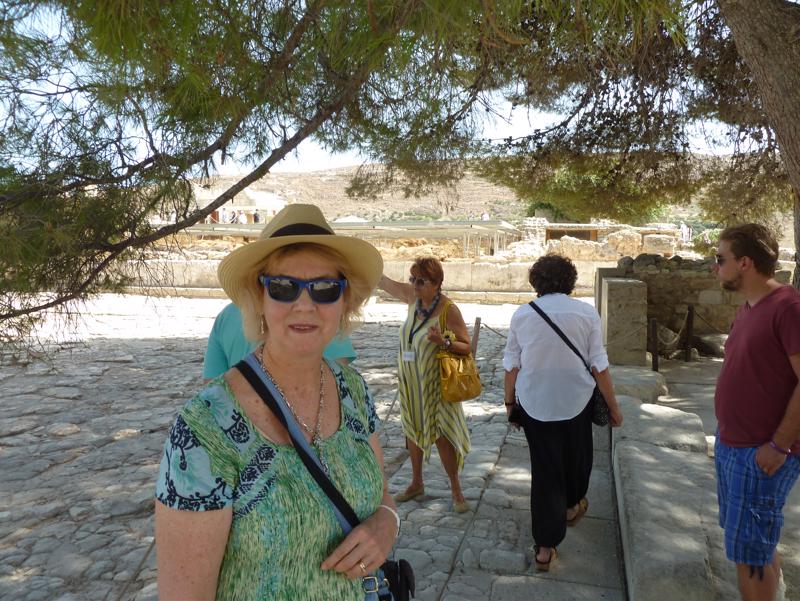
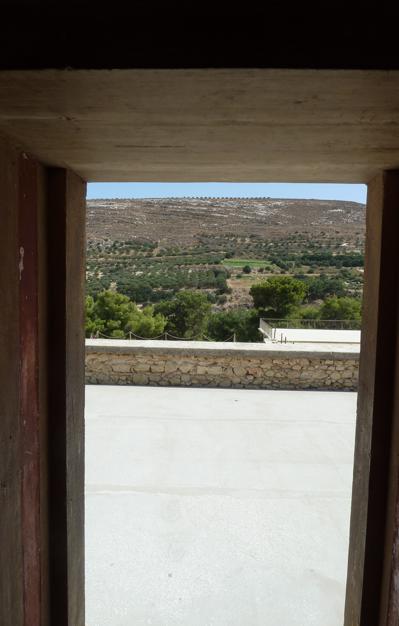
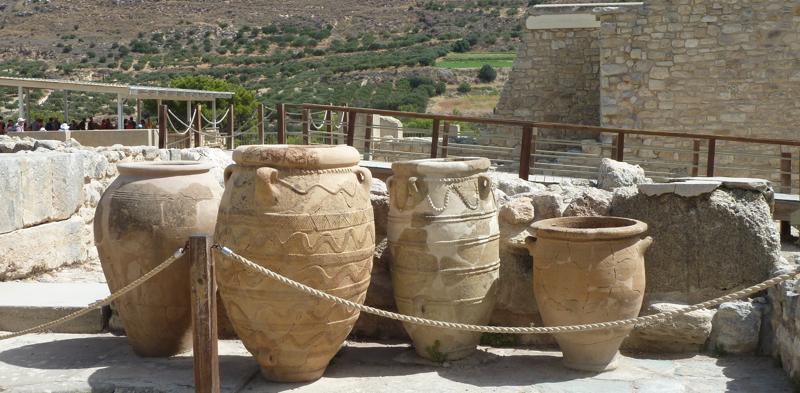
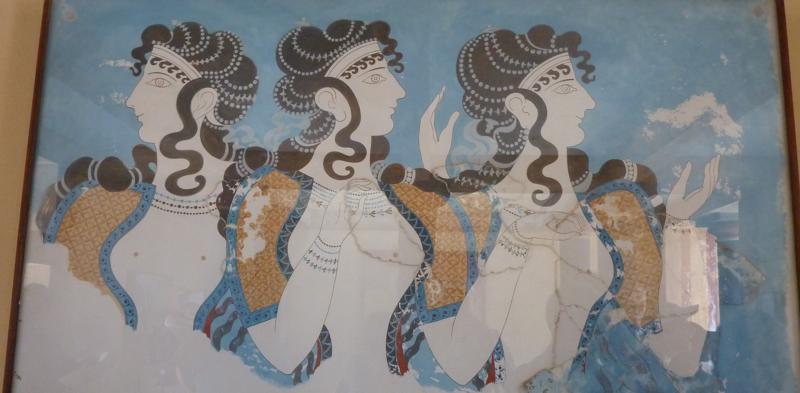
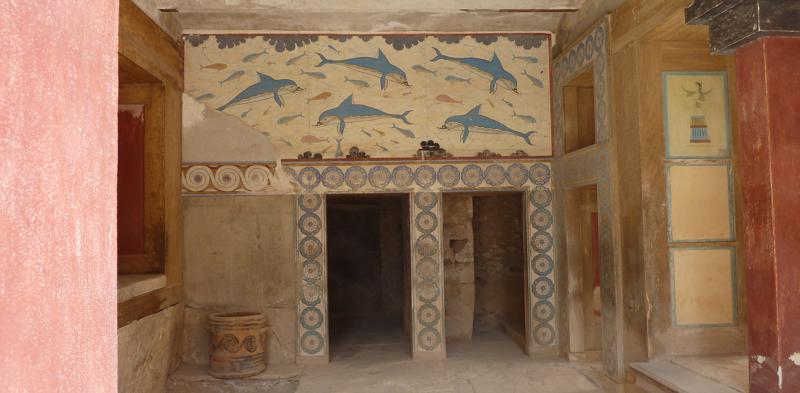
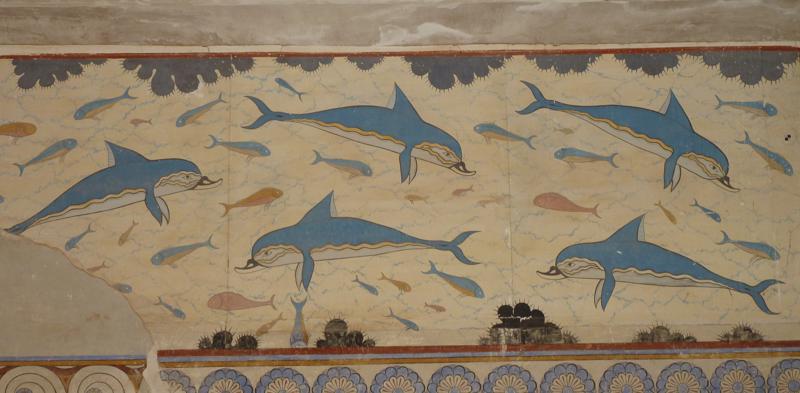
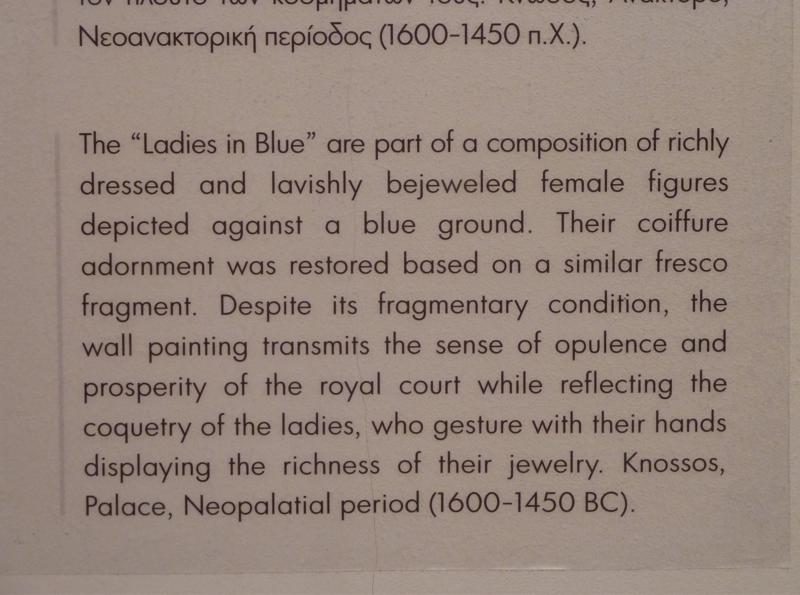
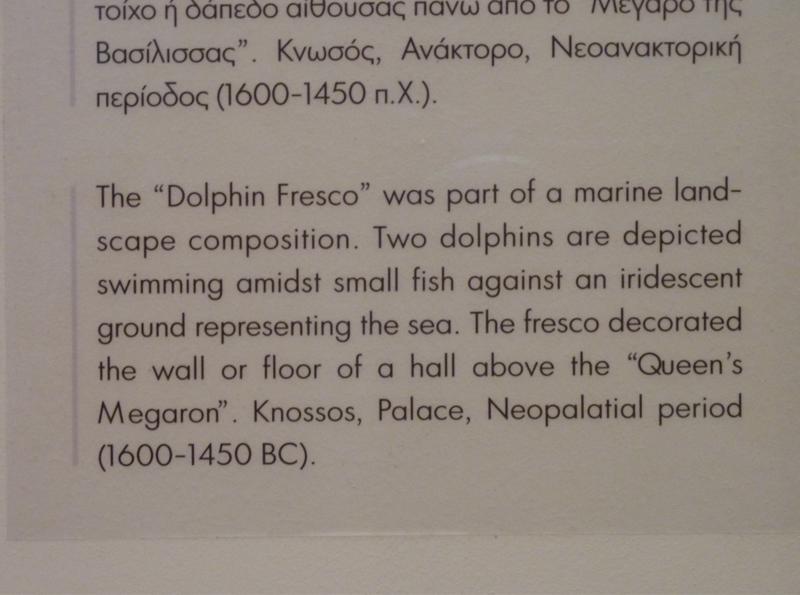
king of Knossos and that the residential quarters of the royal family lay in this part of the site".
The photos opposite and above are presumed to be the quarters of the Queen. It was assumed there was a religious and ceremonial use of the room as the artwork is highly symbolic. The decoration on the alabaster walls is of stylized reeds and palm trees, symbolizing the regenerative powers of nature. It is here that the toilet capable of flushing was found - the only one in the whole palace.
"The West Porch was a roofed area opening onto the court, supported by one column of which part of the gypsum base remains. The east wall was decorated with a bull-leaping fresco. There was a small guard room at the back".
"The porch was closed off by a double door, and from here began the long "Corridor of the Procession". The corridor is so named from the wall painting decorating its east wall and depicting a procession of

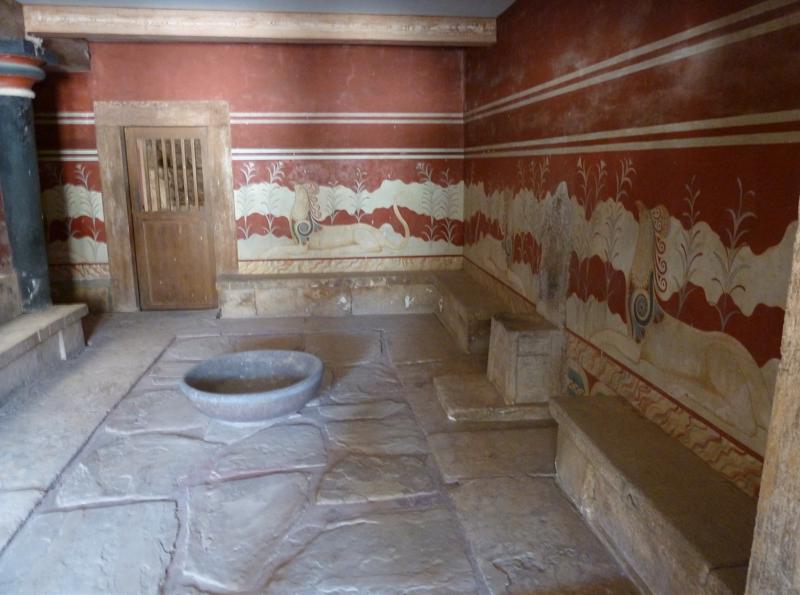
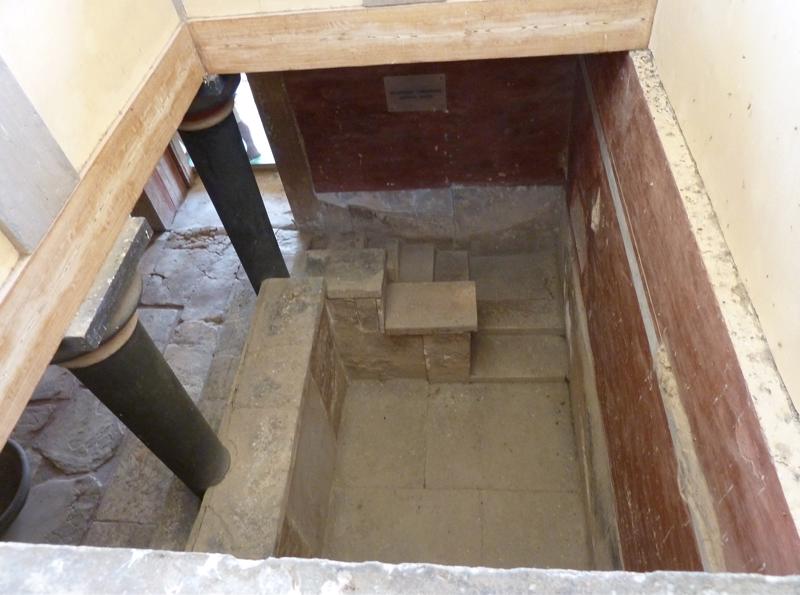
people holding gifts, and musicians. The floor is very fine. The corridor continued onto the Central Court".
Our guide told us that the men carrying the large jars with the small opening in the bottom, would keep their hands under the opening so as not to spill the contents (probably a precious oil). When they carry the jars with their arms down, it means the jar is empty. There were many of these triangular shaped jars of all different sizes. Some must have been very heavy when full. We also heard from our guide that the costume worn by the men was weighted down with a number of small metal pieces or stones, similar to a table cloth being weighted down at the corners to prevent it from flying upwards.
Another fresco shows a drawing of men and women with a finer sketch at the base of three women. Our guide tells us that the males were always depicted in red paint and the females in white paint.
At the end of our guided tour, we are exhausted with the heat and oppressive humidity. My sunscreen makeup has well and truly slid off
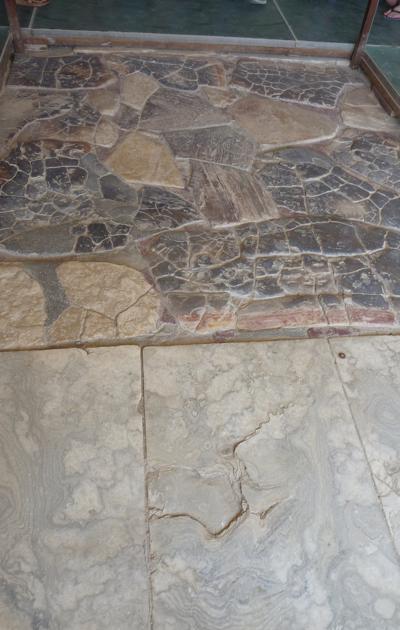
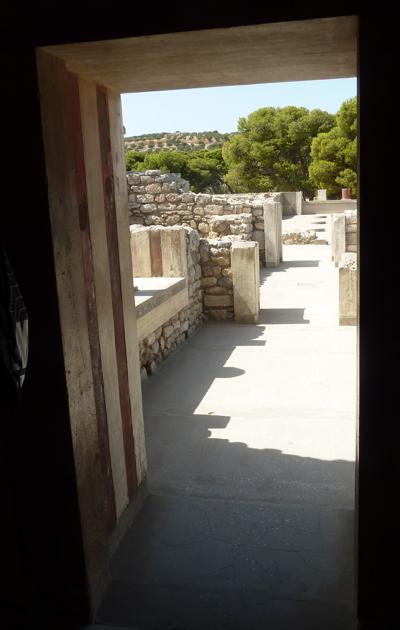
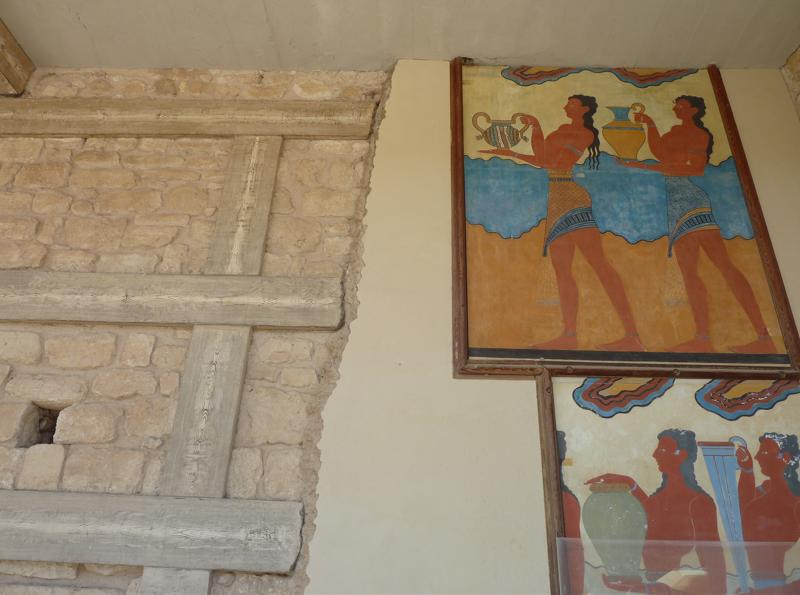
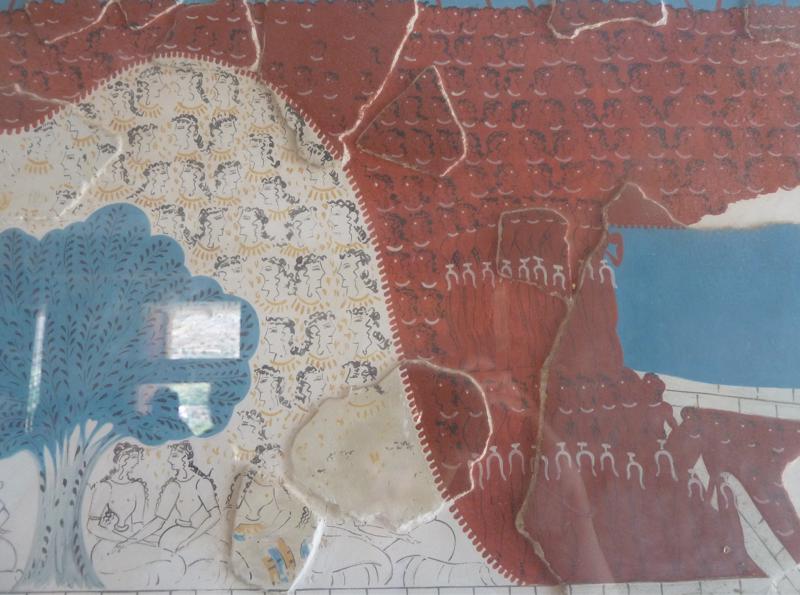
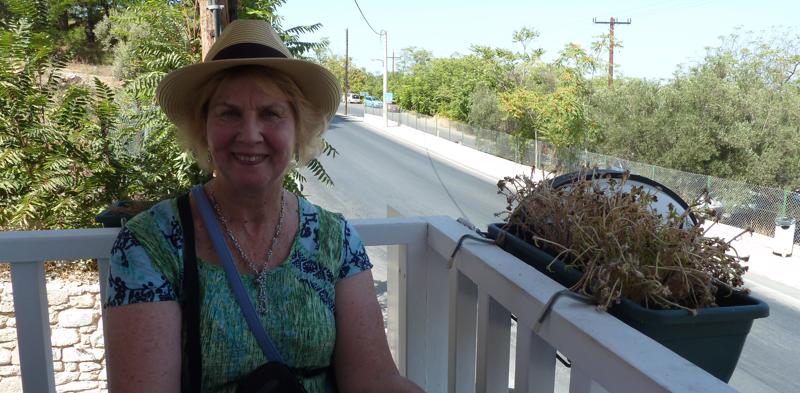
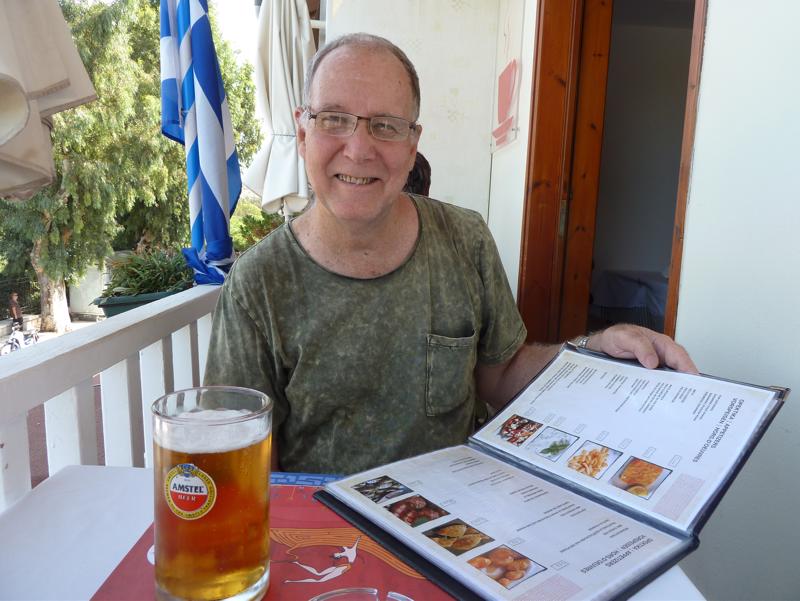
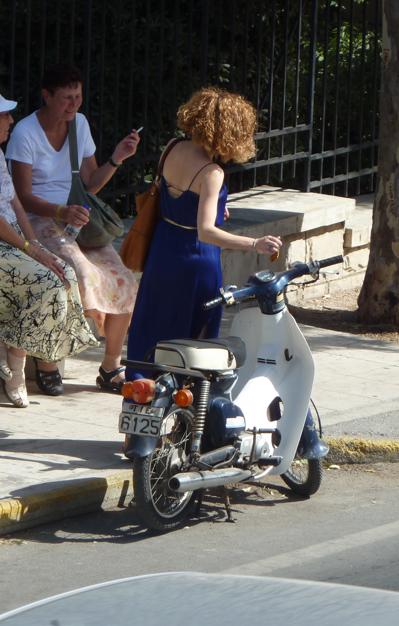
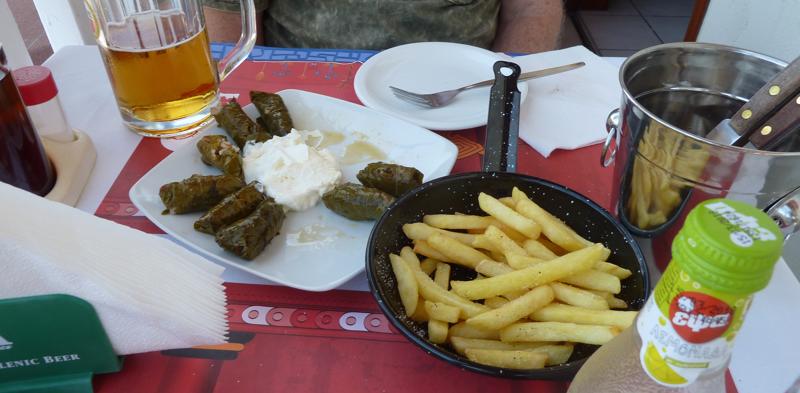
my face by now and my cheeks are flushed. Tony is heading for somewhere to sit down and hopefully find a drink - alcoholic if possible!
We stumble into a little cafe, where a young man had smilingly touted us on the way to the site earlier, and are led upstairs where there might be a slight breeze, and take our seats on the balcony. Tony orders a very cold beer and I ask for a very cold lemon soft drink. Delicious! We eat chips and dolmios and watch the busloads of tourists arriving and departing for Knossos. A smartly-dressed young woman alights from a motorbike just below us. No helmet and in high heels. A great way to live life. A couple of older women are smoking nearby. Greece certainly is a land of smokers. They don't even look as if they are interested in giving away the habit.
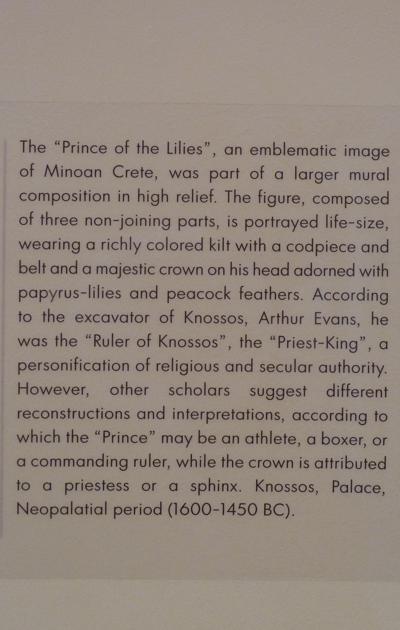
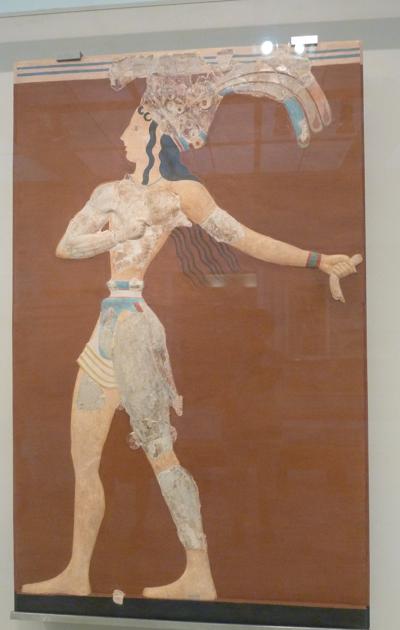
1.
Day 1 & 2 - In Flight
2.
Day 3 - London City
3.
Day 4 - To Ireland
4.
Day 5 - Coach Tour
5.
Day 6 - Dublin
6.
Day 7 - Horses & Crystal
7.
Day 8 - Blarney & Killarney
8.
Day 9 - Ring of Kerry & Cart Rides
9.
Day 10 - En Route to Galway
10.
Day 11 - Troubles & Truce
11.
Day 12 - Giant's Causeway & Titanic
12.
Day 13 - To Scotland
13.
Day 14 - Glasgow
14.
Day Fifteen - Loch Lomond
15.
Day Sixteen - Isle of Skye
16.
Day 17 - St Andrews
17.
Day 18 - Edinburgh Castle
18.
Day 19 - End of Tour
19.
Crete & Knossos
20.
Chania by the Sea
21.
Apartment in Agios Nikolaus
22.
Return to Iraklio
Share your travel adventures like this!
Create your own travel blog in one step
Share with friends and family to follow your journey
Easy set up, no technical knowledge needed and unlimited storage!